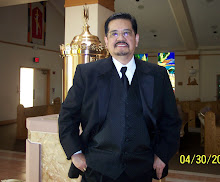It's always good to start the day on a positive note. Then your song
will be on key all day long and at bedtime, you'd be whistling as you turn
the lights off.
One fine sunny Sunday, I drove my
co-navigator, La Veya, (Vicky) to her Zumba class and on my way home, I stopped by our local church, the
San Andres Apostol, to say a prayer to the visiting Image of the Blessed Virgin
Mother, the
Our Lady of Piat.
Then a little miracle happened.
 |
| Our Lady of Piat, enshrined at the San Andres Apostol Church, May 16 - 18, 2014 |
Our Lady of Piat came visiting our Church all the way from the northern province of Cagayan, a valley. I'd been to Cagayan many years ago. It is a lovely place - clean and charming, but very hot. These summer days, it's temperature hovers between 32 - 39 degrees Celsius.
Our Lady of Piat, a bronzed image of Our Blessed Mother carries in her arms the image of the infant Jesus. She is said to have originated from Macau.
ORIGINS.
"The itinerary of the Blessed Image of Our Lady of Piat started in Macau from where it was brought to Manila in 1604.
Its first home was the convent of the Santo Domingo in Intramuros. From Manila she was taken to Nueva Segovia (now Lal-lo) to aid in the evangelization of the
Itawes region, covering the towns of Tabang, Malaweg, Tuau (now Tuao)
and Piat until it was brought to and stayed on Piat for five years.
No
description of the image is given by any of the historians, though it is
often mentioned that is "of talla (sculpture)" made from paper-masche.
Eventually the image was taken to Piat, and erected on a side altar. It was not long when the people felt special manifestations of divine
favors through Our Lady. Their love and devotion to Our Lady had grown
with the years, and attachment to her image bordered fanaticism. This was
clearly seen when Fr. Juan de Santa Ana sent the same image to Tuguegarao in 1622 and ordered another one more beautiful from Manila to replace the image.
In no time, the people rose up in public protest and asked to the point
of insistence that the original image be returned to them. Knowing the
peculiar character of the people, Fr. de Santa Ana finally gave in, and
the image was brought back amid great rejoicing of the people. There
arose, however, a dispute between the people of Piat and Tuao as to
where the sanctuary should be constructed. Happily, solomonic solution
was found, and it was agreed to have the sanctuary built between Piat
and Tuao."
BASILICA MINORE.
The lady is enthroned at the Basilica Minore Nuestra Senora de Piat which was recognized as a shrine by the Vatican on June 22, 1999.
It celebrates its feast every July 2 wherein the Lady is drawn for a procession.
 |
| The Basilica Minore Nuestra Senora de Piat in Piat, Cagayan. |
Today, Our Lady of Piat is considered one of the oldest Marian images in the
Philippines. On June 20, 1954, in a ceremony led by papal delegate
Egidio Vagnozzi, she was named “Queen of Heaven and Earth.” The Ibanags
call her
“Yena Tam Ngamin” (Mother of Us All) and to the natives of Piat, Cagayan, she is known as
“Apo Baket” (Grand Matriarch). Many miracles had been attributed to her.
On that fine Sunday morning as La Veya emerged from her Zumba class, she passed by the San Andres Apostol Church to buy souvenir items of the Lady. There were just two images of the Lady remaining, and she didn't have enough money in her coin purse. The cost of the image was 350 pesos.
She implored the
Manang (lady vendor) to reserve one for her and that she'd come back for the payment later that day.
About the same time, another church worker came out of the church from rosary prayers, saw her and told her how she felt a prompting to go home. This church worker had bought a T-shirt uniform weeks earlier from her and had not paid yet. So when the church worker saw La Veya, she immediately said she'd go to her house to get the money. The cost of the T-shirt: 350 pesos.
La Veya was able to buy the image of Our Lady of Piat, who was scheduled to return home to Piat in Cagayan that evening of Sunday.
In the early afternoon on our way to run errands, we passed by the church again to bid Our Lady of Piat our last farewell.
ADIEU Our Dear Mother, Our Lady of Piat.
Be safe on your journey home and grant us safety, too, in the journeys of our lives.

 In the mid-90's, the Holy Cross Church was built, farther from the center of politics (the Municipal Hall) and still farther from the nexus of trade (the local wet market). The new church is fondly called "simbahang bago," (new church) by the locals.
In the mid-90's, the Holy Cross Church was built, farther from the center of politics (the Municipal Hall) and still farther from the nexus of trade (the local wet market). The new church is fondly called "simbahang bago," (new church) by the locals. 




























